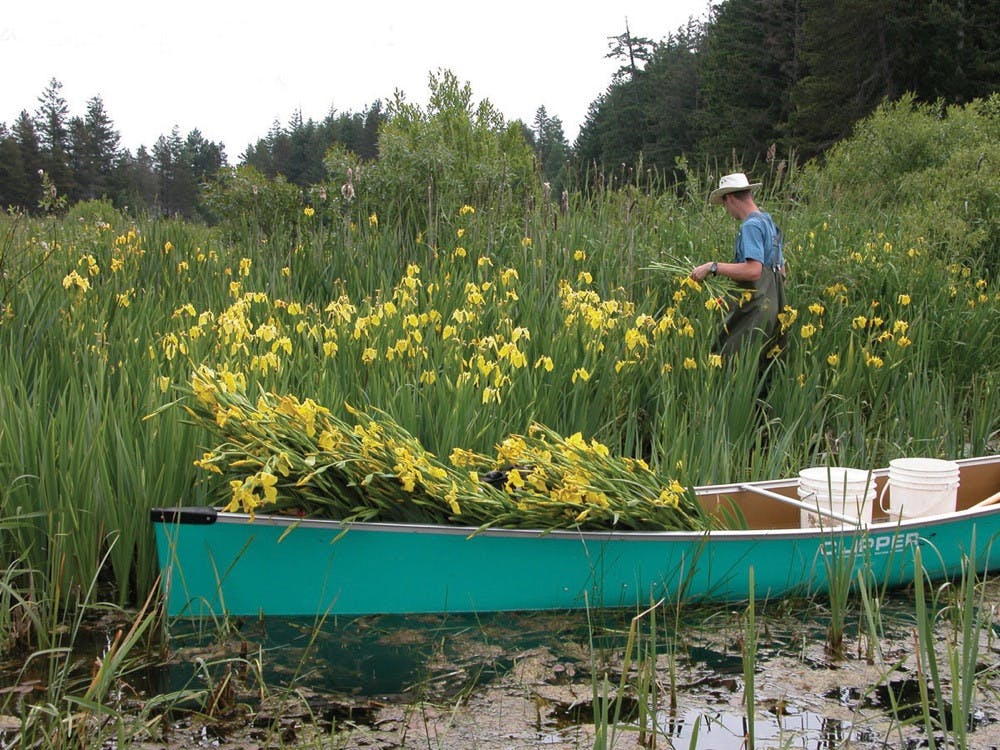MIDDLEBURY — Deceptively beautiful, the Yellow iris (Iris pseudacorus), a vibrant yellow flower that looks like it could belong in a cheerful garden, is actually a dangerous invasive species that is classified by the Vermont Agency of Agriculture as a Class B Noxious Weed. According to the Connecticut Invasive Plant Working Group, the yellow iris is “a perennial that grows to a height of 1 to 3 feet, with grassy or sword-like leaves and showy, lemon-yellow flowers from May to July.” The yellow iris is a native plant of Europe, and can be found growing along the edges of lakes, ponds, rivers, and streams, and immersed in water up to 25 cm (10 in.) deep.
So why is this beautiful flower a danger to wildlife, especially in Lake Champlain’s wetland area and flood plains forest areas in Vermont? The yellow iris grows at an accelerated pace that threatens to out-compete surrounding native species. This plant reproduces through rhizomes and seeds, which are carried down waterways, and spread rapidly. According to the Lewis Creek Association, here in Vermont, the “Lower Thorp Brook is a diverse beaver-influenced corridor, and serves as the primary iris seed source for the wetlands at its confluence with Lake Champlain.” The yellow iris’ rhizomes create a thick mat that prevents other wildlife’s seeds from germinating. This dense growth of the iris can clog irritation systems and streams and, by trapping sediment in the roots, can narrow waterways.
One plant — the native green arrow arum (Peltandra virginica) — is in direct competition with the Yellow iris. The arrow arum is an important source of food for the wood duck. The Yellow iris also crowds out other vital aquatic plants, such as cattails and other native irises. This causes a lack of space, nesting areas and accessible food sources for many native wildlife and fish.
In Vermont, the Yellow iris is becoming increasingly more present in various wetlands and bodies of water in the Lake Champlain watershed that are considered “priority natural communities.” According to the Lewis Creek Association, “these wetlands are considered state waters, comprising a fifty-three acre matrix of wetland natural communities, whose value has been acknowledged by VT DEC, VT FWD Natural Heritage Program and TNC experts. The lake-influenced lower reaches of Lewis Creek contain important floodplain forests, buttonbush swamps and a range of state significant emergent communities.”
The yellow iris not only grows quickly, it is also adaptable to grow in many different ecosystems. Vtinvasives.org warns, “It grows well in freshwater wetlands and can tolerate high acidity. In its native habitat, Iris pseudacorus can tolerate living in the upper zones of salt marshes, where it may be surrounded by saline water.” Due to this flexibility, the yellow iris has been able to thrive and continues to spread in many areas across the United States. In addition, the yellow iris is toxic to all livestock and grazing animals, and contains toxins that cause minor skin irritation to humans.
To tackle this pressing issue, the Lewis Creek Association (LCA) began a long-term project in 2015 to identify high concentrations of yellow iris and remove iris when possible. According to www.lewiscreek.org, “LCA received a grant from LCBP [Lake Champlain Basin Program] to continue this work in 2017, which will: 1. Fund the preparation of a management plan and treatment of yellow iris in the lower Thorp Brook areas, with a targeted 90 percent reduction of iris. 2. Meet with professional experts and landowners in Lower Lewis Creek (a priority Natural Heritage area with increasing high yellow iris infestation levels) to discuss and identify mutually agreeable yellow iris control options.”
In order to remove the yellow iris from its location, and prevent it from spreading, it must be manually dug out, or, in certain cases, an herbicide treatment has been proven successful. Through the grant given to LCA by the LCBP, the Lewis Creek Association has been able to “quantify current levels of infestation, characterize the rate of spread and behavior of the exotic species at both a landscape level and within priority natural communities and identify best control methods by evaluating available control options including manual and herbicide-based control.”
Moving forward, “This year’s control work builds upon two seasons of studying and mapping iris infestation, threat and spread; and validating control methods in the lower reaches of Thorp Brook,” according to Krista Hoffsis, Program Coordinator of LCA.
The LCA is avidly working towards the removal of the Yellow iris, due to its devastating effects upon priority natural communities in the Lake Champlain wetlands and flood plain forests of Champlain direct drainage stream. Through access to grants and hard work from volunteers and employees, the LCA is in the process of mapping survey areas impacted by the yellow iris, tracking growth patterns and occurrences, completing site assessments and utilizing GPS points and flagging (LCA Iris Final Report).
The battle over the yellow iris and other invasive species rages on, but through dedication and commitment, hopefully the Lake Champlain area will soon be free of the iris’ threat to the gorgeous local wildlife that is vital to Vermont’s natural splendor.




